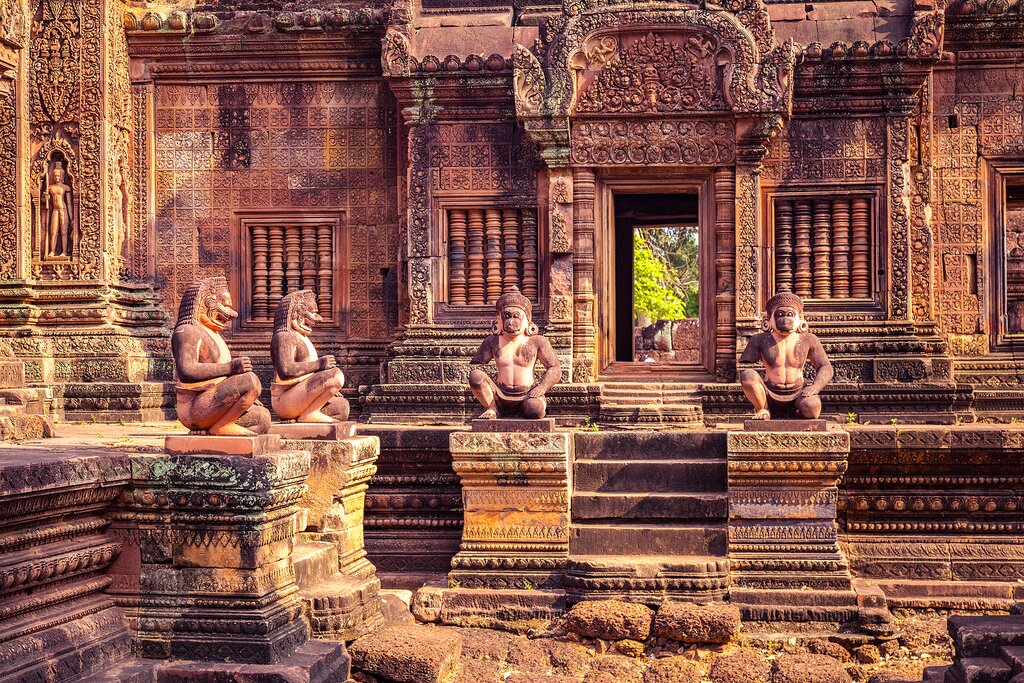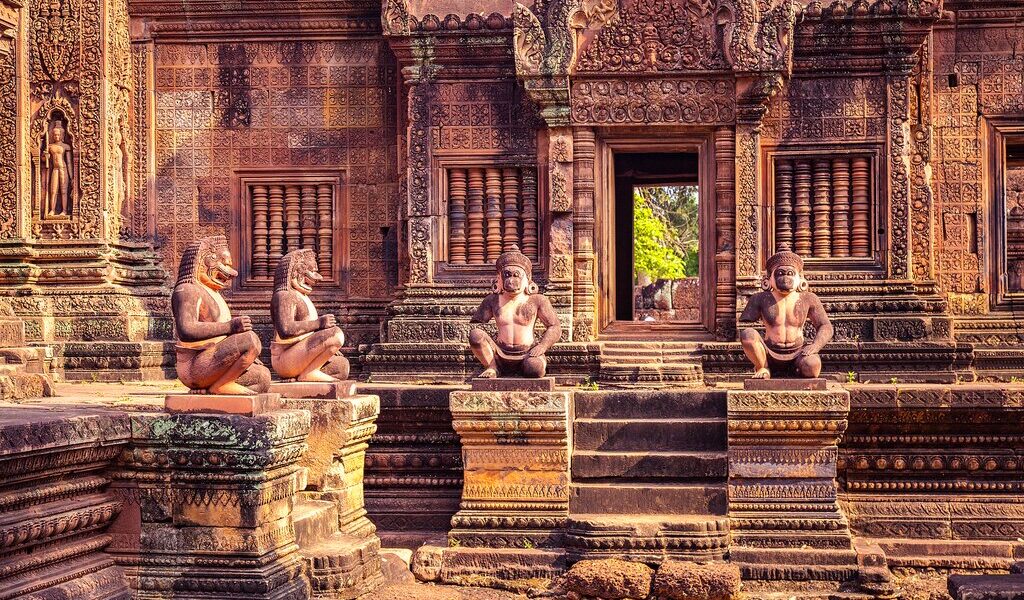
August is right in the middle of Cambodia’s wet season, which also happens to be the low season. But these factors don’t make it a bad time to visit—if you’re prepared for a bit of rain, you can enjoy some of Cambodia’s highlights with few other travelers around. Culture and history enthusiasts should head to the ancient city of Angkor, while nature and wildlife lovers should spend some time around Tonlé Sap. Read on to find out more.
## Exploring Cambodia in August: A Comprehensive Guide
Cambodia in August offers a unique travel experience, characterized by the heart of the wet season. While rain is a daily expectation, the benefits of traveling during this period are numerous, from fewer crowds to a revitalized landscape. Let’s delve into the specifics to help you plan your Cambodian adventure.
**Weather Considerations**
The Cambodian wet season holds sway from June through October, placing August squarely in its midst. Although not the absolute wettest month – that title belongs to October – expect daily rainfall, most predictably in the afternoons. These showers, often short and intense, can be a welcome respite from the prevailing heat and humidity that characterizes the mornings. Think of them as nature’s way of refreshing the air and the landscape.
Interestingly, the early stages of the wet season are often appreciated by the local population in rural areas. The arrival of rain is a cause for celebration, bringing much-needed water for agriculture and replenishing natural resources. Conditions are typically not as waterlogged or muddy as they can become later in the season when the rains intensify. The period from June to August is often referred to as the “green season,” a fitting name as the landscape undergoes a dramatic transformation, bursting back to life after months with limited rainfall. A vibrant array of fresh produce also becomes available during this time, adding to the appeal for food enthusiasts.
However, as the wet season deepens and the rains grow heavier, it’s important to note that some road routes across the country may experience damage, such as landslides or washouts. This can potentially slow down long-distance travel, particularly when venturing into more rural and remote areas. Planning your transportation carefully and being prepared for potential delays is therefore crucial.
In terms of temperature, August tends to be slightly cooler than the average for Cambodia, although it remains decidedly hot, befitting its tropical climate. In the bustling capital city of **Phnom Penh**, the average temperature in August hovers around 84°F (29°C). However, the high humidity can significantly intensify the perceived heat, making it feel even warmer than the thermometer indicates. If you’re planning on spending time outdoors, staying hydrated and taking breaks in shaded areas is highly recommended. Temperatures at higher elevations in the mountains will naturally be somewhat cooler, providing a refreshing escape from the lowland heat.
**Crowds and Costs: The Advantages of Low Season**
The wet season corresponds with the low season for tourism in Cambodia, but this shouldn’t deter you from considering a visit in August. In fact, the lower tourist numbers can be a significant advantage, allowing you to experience the country’s attractions with more breathing room. You’ll find fewer crowds at the most popular sites, particularly within the magnificent ancient city of **Angkor**.
The **Angkor** complex is vast, covering a remarkably large area. Some archaeological findings even suggest that its size rivals that of modern-day Los Angeles. This sprawling scale means that certain areas, particularly the “outer temples” located further from the main tourist routes, can be practically deserted during this time of year. Imagine exploring these incredible historical sites in relative solitude, offering a truly immersive and reflective experience. When visiting, waterproof shoes are advisable as you might encounter mud and puddles, especially around the less frequented temples.
Accommodation options, particularly more upscale hotels, may offer off-season specials and discounts to attract visitors during this quieter period. However, it’s worth considering that conditions in August are generally not ideal for a beach vacation. Therefore, booking a beach resort, even if you find a tempting deal, might not be the best use of your travel budget. Instead, focus on finding deals around **Siem Reap**, the vibrant town that serves as the gateway to **Angkor**. Keep in mind that Cambodia is generally an affordable destination for travelers, even during the peak season, so you can expect reasonable prices for accommodation, food, and transportation.
**Exploring Cambodia: Where to Go**
**Tonlé Sap** is a major geographical feature of Cambodia, a large inland lake that feeds into the **Tonlé Sap River**, which in turn flows through **Phnom Penh** before eventually joining the mighty **Mekong River**. The lake’s water level, and consequently the experiences it offers, varies dramatically throughout the year in response to the changing rainfall patterns. By August, the lake should be at a high level, providing optimal conditions for boat trips and wildlife viewing. Birds, which often migrate away during the drier months, will have returned to the area, creating excellent opportunities for birdwatching.
Boat trips on the **Tonlé Sap** are a fantastic way to observe the local wildlife and experience the unique floating villages that dot the lake. For serious bird enthusiasts, dedicated bird-watching tours depart regularly from **Siem Reap**, offering a more specialized and in-depth exploration of the region’s avian life.
Another unique travel option is to take a water bus from Siem Reap to Phnom Penh. This journey traverses the **Tonlé Sap** lake and then navigates down the **Tonlé Sap River**, offering a scenic and comfortable alternative to the potentially less comfortable long-distance buses. This is particularly appealing during the wet season, when some roads may be damaged or muddy, making road travel slower and less enjoyable. However, it’s important to note that this water bus service doesn’t operate when the water levels are too low. Fortunately, this is unlikely to be an issue in August, when the lake is typically full.
**Unforgettable Activities: What to Do**
Besides the captivating birdwatching opportunities on the **Tonlé Sap**, August is an excellent time to delve into the rich history and explore the ancient civilizations at **Angkor**. As mentioned earlier, the wet season offers the advantage of fewer crowds, allowing for a more intimate and contemplative experience. Provided you’re equipped with appropriate rain gear, the benefits of visiting during this time far outweigh any potential inconvenience. While the iconic centerpiece, **Angkor Wat**, inevitably attracts a steady stream of visitors, some of the outer temples and lesser-known archaeological sites can be virtually deserted. This provides a unique opportunity to imagine what the vast city might have looked like before its “rediscovery” in the 1840s, a truly awe-inspiring thought.
For travelers seeking to venture beyond the central **Angkor Wat** temple, several other remarkable sites are well worth exploring. **Bayon Temple**, famous for its enormous faces carved into the stone towers, is a must-see. **Ta Prohm**, with its dramatic tangles of tree roots engulfing the ancient structures, offers a captivating blend of nature and history. And **Banteay Srei**, with its intricate pink sandstone carvings depicting scenes from the Hindu epic Ramayana, is a testament to the artistry and craftsmanship of the Khmer civilization. Given the sheer size and scope of the ancient city, many of its temples remain relatively unknown, offering the potential for unexpected and rewarding discoveries. Embrace the spirit of adventure and prepare to uncover your own hidden gems within the **Angkor** complex.
(Word count: 1152)
B-230

